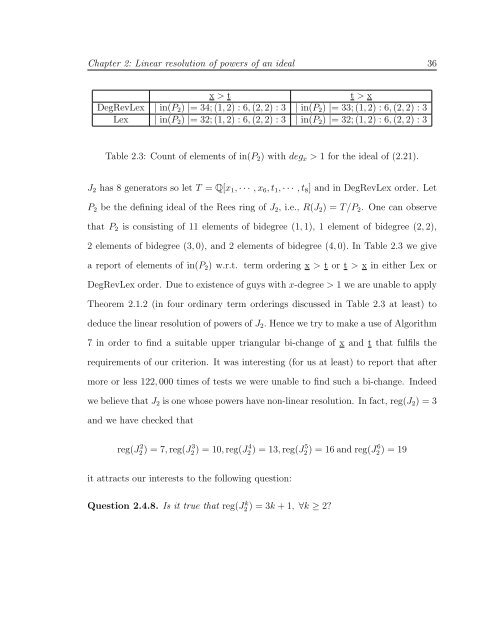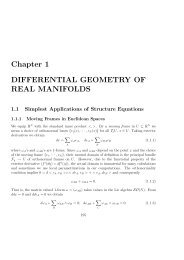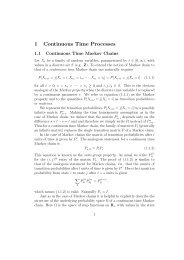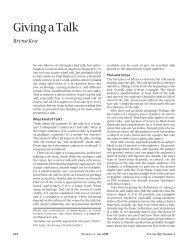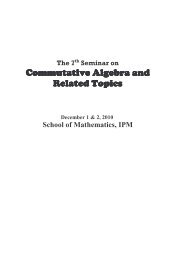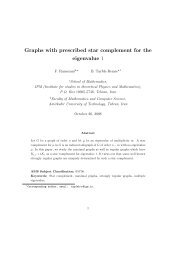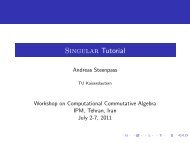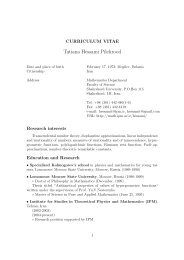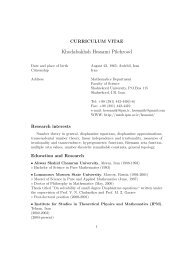Betti numbers of modules over Noetherian rings with ... - IPM
Betti numbers of modules over Noetherian rings with ... - IPM
Betti numbers of modules over Noetherian rings with ... - IPM
You also want an ePaper? Increase the reach of your titles
YUMPU automatically turns print PDFs into web optimized ePapers that Google loves.
Chapter 2: Linear resolution <strong>of</strong> powers <strong>of</strong> an ideal 36<br />
x > t t > x<br />
DegRevLex | in(P2) |= 34; (1, 2) : 6, (2, 2) : 3 | in(P2) |= 33; (1, 2) : 6, (2, 2) : 3<br />
Lex | in(P2) |= 32; (1, 2) : 6, (2, 2) : 3 | in(P2) |= 32; (1, 2) : 6, (2, 2) : 3<br />
Table 2.3: Count <strong>of</strong> elements <strong>of</strong> in(P2) <strong>with</strong> degx > 1 for the ideal <strong>of</strong> (2.21).<br />
J2 has 8 generators so let T = Q[x1, · · · , x6, t1, · · · , t8] and in DegRevLex order. Let<br />
P2 be the defining ideal <strong>of</strong> the Rees ring <strong>of</strong> J2, i.e., R(J2) = T/P2. One can observe<br />
that P2 is consisting <strong>of</strong> 11 elements <strong>of</strong> bidegree (1, 1), 1 element <strong>of</strong> bidegree (2, 2),<br />
2 elements <strong>of</strong> bidegree (3, 0), and 2 elements <strong>of</strong> bidegree (4, 0). In Table 2.3 we give<br />
a report <strong>of</strong> elements <strong>of</strong> in(P2) w.r.t. term ordering x > t or t > x in either Lex or<br />
DegRevLex order. Due to existence <strong>of</strong> guys <strong>with</strong> x-degree > 1 we are unable to apply<br />
Theorem 2.1.2 (in four ordinary term orde<strong>rings</strong> discussed in Table 2.3 at least) to<br />
deduce the linear resolution <strong>of</strong> powers <strong>of</strong> J2. Hence we try to make a use <strong>of</strong> Algorithm<br />
7 in order to find a suitable upper triangular bi-change <strong>of</strong> x and t that fulfils the<br />
requirements <strong>of</strong> our criterion. It was interesting (for us at least) to report that after<br />
more or less 122, 000 times <strong>of</strong> tests we were unable to find such a bi-change. Indeed<br />
we believe that J2 is one whose powers have non-linear resolution. In fact, reg(J2) = 3<br />
and we have checked that<br />
reg(J 2 2 ) = 7, reg(J 3 2 ) = 10, reg(J 4 2 ) = 13, reg(J 5 2 ) = 16 and reg(J 6 2 ) = 19<br />
it attracts our interests to the following question:<br />
Question 2.4.8. Is it true that reg(J k 2 ) = 3k + 1, ∀k ≥ 2?


